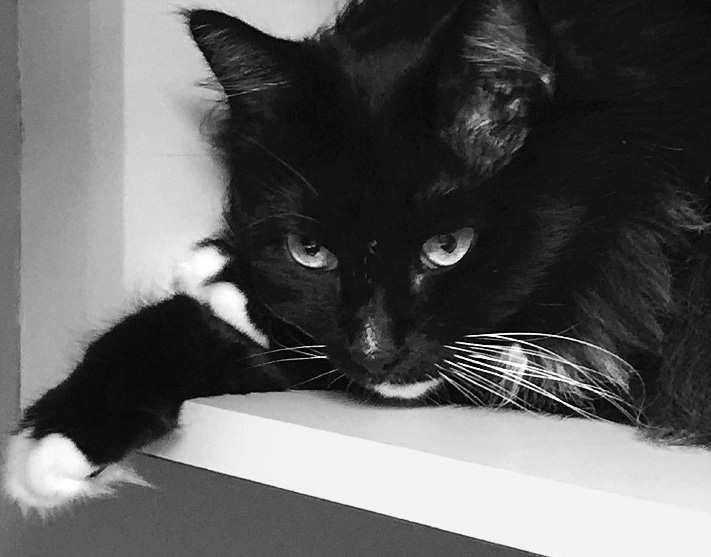
Maggie is a nine-year-old domestic longhair with a tuxedo coat pattern who was adopted from a local shelter.
Kelly Moffat
Kelly Moffat, DVM, DACVB
He strutted around the room with purpose. This one-year-old Bengal was friendly, engaged, inquisitive, and empowered. I knew right then that Nancy, a senior citizen, had a problem. “He is just so beautiful,” Nancy gushed. “Isn’t he the most gorgeous cat you have ever seen?” I nodded to show my attention and support. She added, “I just don’t understand why he gets so angry.”
I scanned her bruised hands and arms, marked with bite and scratch wounds in various stages of healing. Her thin skin and daily blood thinner medication made these wounds even worse. “I have already had several emergency room visits and was hospitalized for a few days after Zeus bit me particularly hard. I just don’t know what to do, Doctor—I love him so much!”
As a general practitioner for twenty-five years and a veterinary behaviorist for fourteen years, I can identify a cat like Zeus in just a few minutes. The history I took from Nancy confirmed my suspicions. Zeus indeed was a gorgeous specimen of the Bengal lineage of cats. He was active, intelligent, and very outgoing. His personality, however, was a struggle for Nancy. She hadn’t provided him with enough of the environmental and interactive enrichment he craved, so he used her as an outlet for his intense (and normal) predatory and play behaviors.
When Nancy became frustrated with the attacks, she began to use more verbal and physical punishments with Zeus, such as swatting at him and spraying water. This only made his rambunctious play worse. As he matured, his play became more demanding, and Nancy’s rebukes were met with defensive and then more offensive aggression, as Zeus perceived these interactions to be more punitive than positive.
Nancy admitted that she would prefer a lap cat who would enjoy her more sedentary lifestyle. Yet despite my encouragement for her to find Zeus a more appropriate home, Nancy is still struggling to make the best possible environment for him and to change her interactions with him. And she continues to see occasional bouts of aggression from him.
Bringing a new cat or kitten into your home is a big decision. Many cats live fifteen years or more, so it’s important to plan for this huge commitment. Often, owning a cat will dictate future living situations, partners, jobs, and activities. There are a lot of decisions to make, such as where to get your new furry addition; whether you should adopt an adult or a kitten, a male or a female; and whether you want a pedigree or mixed-breed cat. Choosing the right one is vital for both your and the cat’s long-term well-being.
A fair amount of research is available showing how breed, sex, age, and other aspects of a cat’s past can affect his lifelong personality and behavior. In this chapter, I’ll clear up some questions and concerns in these areas and give you some facts that will help you choose the right feline friend for you. Then I’ll focus on how you can provide the right environment for this new member of your family, what veterinary care and grooming he will need, and how to keep your cat and your house safe while also respecting the other members of your human and pet family.
Where should you get your new cat? Because of the pet overpopulation problem, getting your new friend as a stray or through a shelter or rescue group is a noble idea and one fully supported by the data on cats in shelters. Approximately 6.5 million companion animals enter US animal shelters nationwide every year—about 3.3 million dogs and 3.2 million cats. Each year, approximately 1.5 million shelter animals are euthanized (670,000 dogs and 860,000 cats).
According to a national survey of pet owners conducted by the American Pet Products Association for 2017–2018, 95 percent of cats were obtained someplace other than a pet store or breeder. The cat may have shown up on the doorstep or been adopted from a shelter, a rescue group, a coworker, or a friend who found a litter of kittens in their backyard or apartment complex.
Some people decide to actively look for a new cat and, being sympathetic to the feline overpopulation problem, visit a local animal shelter or another rescue organization. Most are not looking for a specific breed or even sex of cat. Many are open-minded about adopting either an adult cat or a kitten. They may choose their new pet by the way the cat approaches (or doesn’t) the cage door, the beauty of his coat, or his laid-back or playful personality. Others are sympathetic to a one-eyed or three-legged cat, an older cat, or a timid cat—one they feel may have a poorer chance of being adopted.
Open-admission shelter: A shelter that accepts all animals surrendered to it and may work with the city’s animal control agency. Not all animals surrendered to this kind of shelter get placed for adoption.
Limited-admission shelter: Generally, a privately funded shelter that may accept animals based on breed, behavior, adoptability, age, health, or other criteria. Many of these animals are transferred from open-admission shelters.
Kitten mill: A commercial or large-scale cat breeder, often criticized for having high numbers of kittens in tight spaces and lack of proper hygiene, medical care, and socialization.
Microchip: An implant that allows clinics and shelters to find a pet’s owner if the pet gets lost. This information should be updated as your address and phone number change. This is not a tracking device; it’s solely for identification.
Pedigree, or purebred, cat: A cat who comes from a known line of ancestors of a particular breed. These cats are bred for a specific look and often have behaviors that are characteristic of the breed.
Mixed-breed cat: A cat who is the result of random breeding, usually referred to as a domestic shorthair or domestic longhair.
Hybrid: The offspring of a wild species bred to a domestic cat. Ideally, this type of breeding leads to a cat who looks wild but has a safer, calmer, more domesticated temperament. Hybrids, including Bengals such as Zeus, typically require much more enrichment and a much larger environment.
Temperament: The aspects of an animal’s behavior and personality that are genetically based.
Heredity: The act of passing traits from parents to their offspring. Many behavioral traits in cats, such as friendliness, can be inherited. Conditions that lead to diseases such as heart or kidney disease can also be inherited from a parent or other relative.
Sensitive socialization period: The time (two to seven weeks) when a kitten is most open to learning about his surroundings, including his mother, littermates, environment, other animals, and humans. During this period, kittens are more likely to approach, explore, and show little fear when encountering new animals, people, objects, and situations. Providing a wide variety of positive experiences during this period can help prevent a kitten from experiencing fear, anxiety, and aggression as an adult.
Many different types of shelters house stray, lost, abandoned, and surrendered animals. Some are run by the local government, but far more are independently operated as nonprofit animal welfare organizations. There is no national organization that oversees or regulates shelters, although many individual states and municipalities do regulate shelters within their jurisdiction.
If you adopt from a well-funded, responsible shelter, you will generally get a pet who has been examined by veterinary staff, vaccinated, evaluated for temperament, and often spayed or neutered. Many shelters lack funding, resources, and proper management, however, so it is important to make sure that any adult cat you are considering adopting has been tested and is negative for feline leukemia virus (FeLV) and feline immunodeficiency virus (FIV); any kitten has been tested for FeLV (FIV testing isn’t accurate in kittens younger than six months old); and the cat has received his first core vaccines, including the one for feline viral rhinotracheitis, calicivirus, and panleukopenia (FVRCP). There is generally a modest adoption fee that helps the shelter cover the cost of care for the cat or kitten.
Many overcrowded shelters have discounted or even free adoption days. People flock to these events and often get caught up in the excitement of adopting a cat at little or no cost. Many of these potential owners, however, are unprepared to cover the costs of an initial veterinary visit, booster vaccinations, and medications for a cat who leaves the shelter with a respiratory infection, as many do. The financial commitment after adoption is the same whether the cat was free or not. Every potential cat owner should be prepared for the day-to-day expenses of providing and caring for their new family member.
Numerous rescue organizations take in stray or unwanted cats, house them in group facilities or foster homes, and work to find them new homes. They may take in cats as transfers from overcrowded shelters or those placed on euthanasia lists because of various behavior or medical issues. They may also take cats from individuals who can no longer care for their pets. Some of these rescue groups are specific to a particular breed, but most are not. Many provide basic medical care, including FeLV and FIV testing, vaccinations, and spaying or neutering.
Not all rescue groups are created equal. Make sure you ask questions and see the medical records documenting testing, vaccinations, and spaying or neutering for the cat you are considering adopting. Some groups have fairly simple applications, while others have lengthy applications and require multiple home visits before approving a potential adopter. They generally charge an adoption fee to help cover the costs of caring for the cat. It’s easy to find cat rescue organizations through an Internet search or by talking to local animal shelters or veterinarians.
You may even get your little tiger at a cat café. The concept of the cat café started in Taiwan, based on the idea that customers can enjoy a hot beverage while also getting in some quality cat time. Since 2014, cat cafés have been spreading across North America. US cat cafés typically host animals from a local shelter and focus on adoptions. They may best be described as a cross between a coffee shop and an adoption center. Interacting with cats in this environment gives potential adopters a good idea of a cat’s personality and can be a great socialization tool for kittens.
There is typically no shortage of stray cats and kittens around housing complexes, mall parking lots, college campuses, and industrial parks. A wayward feline may also show up in your backyard or on your doorstep, looking for food or even companionship.
Before adopting one of these cats, make sure to have him scanned for a microchip and check “lost pet” postings online in places such as The Center for Lost Pets (www.thecenterforlostpets.com), the Missing Pet Network (www.missingpet.net), and Petfinder (www.petfinder.com). Occasionally, someone will find a cat who has wandered away from his owner, and that person has been desperately looking for him. If you can’t find the owner and want to adopt the cat, assume that he hasn’t had any medical care. He will need a veterinary checkup, including FeLV and FIV testing, a scan for external parasites such as fleas, a fecal exam, possibly a deworming medicine, vaccinations, and spaying or neutering. Check with local veterinarians about the costs for all these services; some offer discounts for rescued cats.
These cats are found on social media sites such as Craigslist, community and work bulletin boards, or just about anywhere people post items to sell or give away. They generally have not been to a veterinarian, so you’ll need to treat them the same as you would a stray: they’ll need a general checkup, testing, vaccinations, and spaying or neutering. Be aware that some people may not disclose the real reason they are seeking a new home for their pet. Perhaps the cat has been urinating outside the litter box or destroying their furniture, and they don’t want to deal with the problem behavior themselves. They may also misrepresent or misunderstand the degree to which the cat is social with people.
Pet stores turn a large profit selling popular purebred or mixed-breed cats who come from commercial breeders (known as kitten mills), middlemen, or brokers. The staff members often have little knowledge of the cats’ true origin or the conditions in which they were born and raised. The cats often have illnesses, parasites, and congenital defects that end up being chronically difficult, as well as financially demanding, to treat.
Many pet store chains have stopped selling kittens and instead have created “pop-up” adoption centers hosting cats from local rescue groups or shelters. Be prepared to fill out an application and go through whatever screening process these groups require.
People use the Internet for everything, including looking for a new pet. This is a great way to start the search, because many animal shelters and local rescue groups have their own websites where you can view their adoptable pets and search the site to learn more about the group’s background and mission. You can then call the organization and ask questions before you visit.
Breeders also sell kittens on the Internet, but be cautious if a kitten is coming from outside your area. You shouldn’t buy any kitten sight unseen, and you should try not to have a kitten shipped to you by plane, as doing so will expose him to stressors that can affect him for the rest of his life.
Most cat owners choose a new cat of mixed ancestry rather than a recognized breed. According to the American Humane Association’s U.S. Pet (Dog and Cat) Population Fact Sheet (2013), 95 percent of the cats in the United States are classified as domestic shorthair (DSH). As the name says, these cats have short fur. The rest are domestic longhair (DLH).
You may hear someone refer to their “calico cat,” “tabby cat,” or “tuxedo cat.” These terms describe coat colors and patterns, not breeds. Mixed-breed cats come in a variety of beautiful colors, patterns, and unique combinations. So many need homes, and they can be a great choice for a new cat owner.

Maggie is a nine-year-old domestic longhair with a tuxedo coat pattern who was adopted from a local shelter.
Kelly Moffat
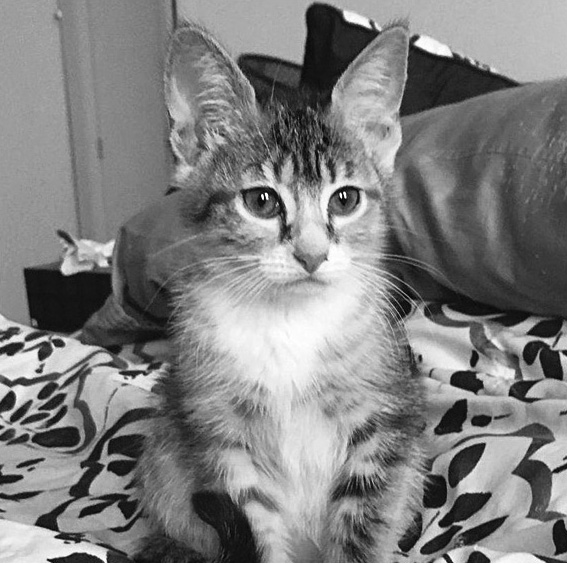
T’Pring is a domestic shorthair kitten with a calico tabby coat pattern who was adopted from a cat café.
Craig Zeichner
Some people really want a particular breed of cat. Perhaps they’ve seen this breed on television, in a magazine, or at a cat show. Unfortunately, some (such as Nancy) are seduced by looks alone and have not done enough research into the breed. They are not well-informed about the personality, activity level, medical concerns, and needs of that breed. Even if they learn about a particular breed, some people believe they will be able to provide for the special needs and behaviors of the breed, but later find themselves unprepared for or intolerant of the actual impact their new cat has on their lives, homes, and loved ones. This creates a heartbreaking situation for everyone—the cat and the people.
Pedigree cats have been bred specifically to exhibit a particular set of physical characteristics. Some of these characteristics may first have appeared as a genetic mutation, such as short legs, folded ears, or a lack of hair. Occasionally, a different species is bred with a domestic cat to form a hybrid, such as the Bengal.
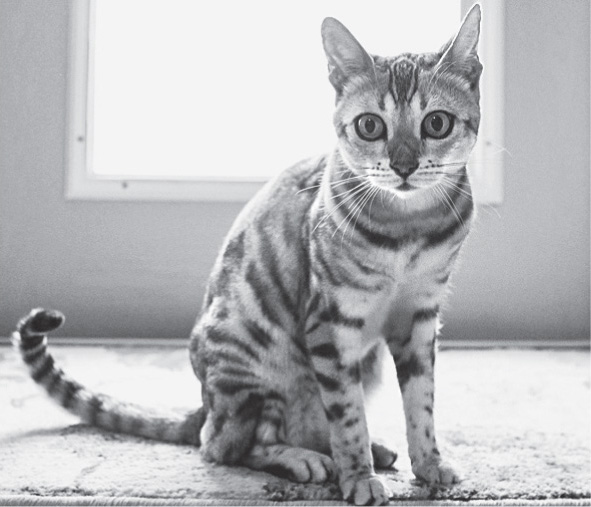
If looks could kill, this Bengal, Sara, would be quite the assassin.
Sheri Johnson
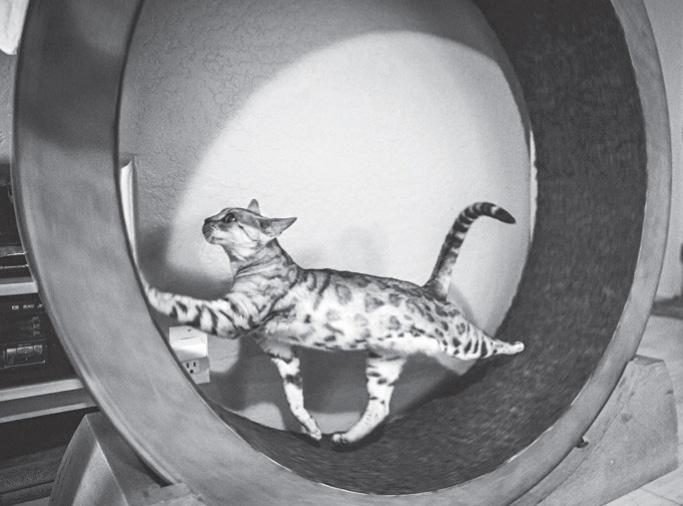
Bengals are a high-maintenance breed, requiring a lot of daily physical and mental exercise. Sara gets her exercise on the carpeted wheel her owners made for her.
Sheri Johnson
Ragdoll
Exotic Shorthair
British Shorthair
Persian
Maine Coon
American Shorthair
Devon Rex
Sphynx
Scottish Fold
Abyssinian
Source: Cat Fanciers’ Association 2018 breed registration numbers.
Pedigree cats are bred only to other cats of the same breed, to maintain the breed’s particular characteristics. This means that the number of cats available for breeding is limited, and the gene pool is small. Problems can arise from a limited gene pool, and if there are heritable health problems or disorders, they are more likely to be passed on to the next generation. Certain conditions, such as heart and kidney disease, can be inherited and lead to a shortened life span.
Problems that exist within a particular closed gene pool are considered inherited, or heritable, disorders. Some universities, such as the University of California, Davis, and the University of Pennsylvania, offer genetic testing to help breeders identify carriers of these conditions. Responsible breeders test all their breeding cats for the inherited disorders that crop up most often in their breed, then design breeding programs that avoid these health problems.
Following are some of the most common heritable diseases.
Hypertrophic cardiomyopathy (HCM) has been documented in Ragdoll, Maine Coon, Himalayan, Burmese, Sphynx, Persian, and Devon Rex cats.
Polycystic kidney disease (PKD) is a disorder caused by a single gene that has often been found in Persians, Himalayans, and Persian-derived breeds.
Progressive retinal atrophy (PRA) has been seen in Bengal, Persian, Abyssinian, Somali, American Curl, American Wirehair, Balinese/Javanese, Colorpoint Shorthair, Cornish Rex, Munchkin, Oriental Shorthair, Peterbald, Siamese, Singapura, and Tonkinese cats, as well as some Ocicats.
Pyruvate kinase (PK) deficiency can be seen in Abyssinian, Bengal, domestic shorthair and longhair, Egyptian Mau, LaPerm, Maine Coon, Norwegian Forest, Savannah, Siberian, Singapura, and Somali cats.
If you are considering buying a cat from a breeder, remember that not all breeders are created equal. Research them thoroughly by doing an online search. Investigate their reputation and find out if they’ve had any complaints lodged against them. Visit their cattery. Ask about testing, vaccinations, medical care, and socialization. A responsible breeder will put the time, energy, and money into producing quality kittens with the best physical and mental health. They will be educated about congenital defects known in the breed and will have tested their breeding pairs to ensure that they will not pass on harmful genetic mutations.

Persians have a brachycephalic (flat) face and are predisposed to some health problems, such as polycystic kidney disease and hypertrophic cardiomyopathy.
Kelly Moffat
Responsible breeders also consider the behavior and temperament of the cats they breed. A breeder should allow you to interact with the parents of a kitten you are interested in, or to talk to owners of cats from previous litters produced by the same breeding pair, so you can better predict a kitten’s adult temperament.
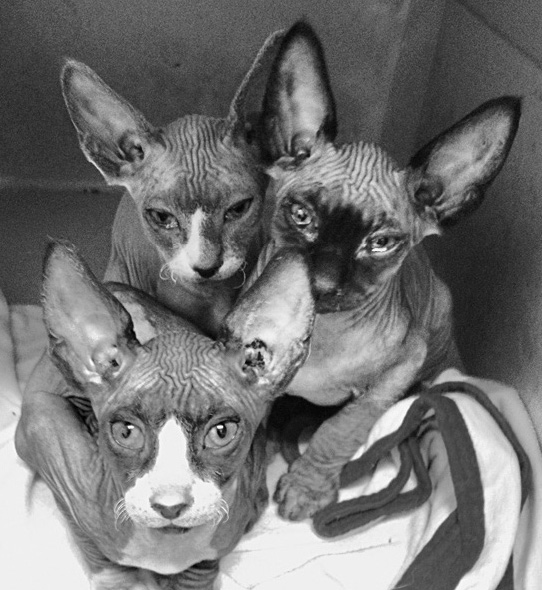
A litter of Sphynx kittens awaits adoption at a veterinary clinic.
Meghan E. Herron
Good breeders handle and socialize their kittens appropriately during the sensitive socialization period (between two and seven weeks of age)—something that doesn’t always happen with rescued cats. This will have an impact on the kittens’ future behavior. As mentioned earlier, there are breed-specific rescue organizations, both local and national, for all breeds of cats. While purebred kittens may be harder to find through a rescue group or shelter, they are out there if you keep a lookout for them.
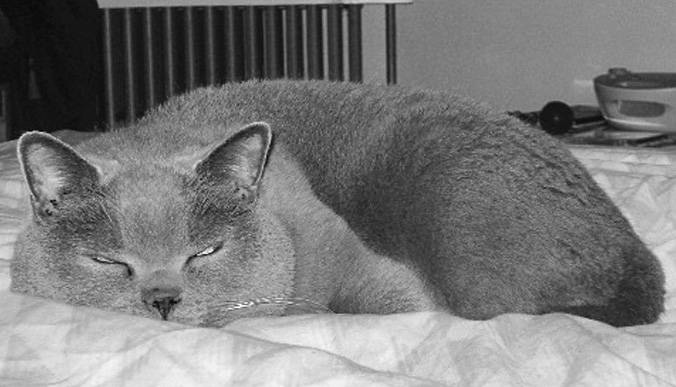
British Shorthairs are big, round, mellow cats. Though more active than Persians, they are calm and friendly.
Carlo Siracusa
Expect to pay hundreds or even thousands of dollars for a pedigree cat, depending on the breed. Even breed-specific rescue organizations might charge a hefty adoption fee. And, as with any cat, you’ll also need to account for veterinary care and everyday expenses such as food, litter, and enrichment.
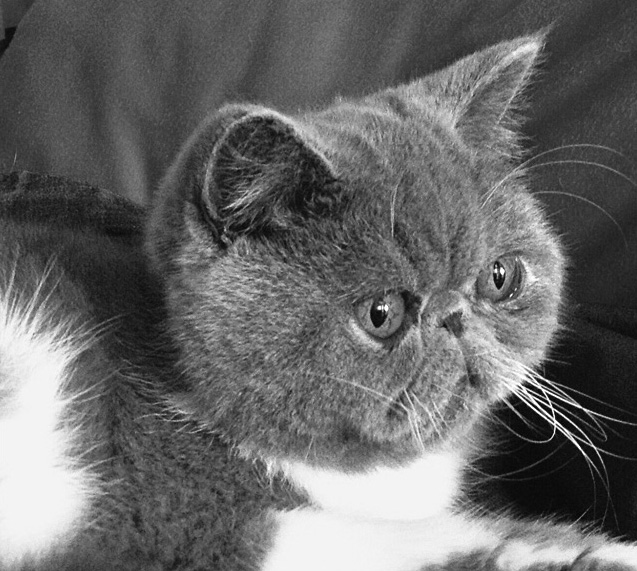
Exotic Shorthairs have the same body and head shape as Persians, without the problems associated with long hair. Typical of this breed, Mishka is a quiet, friendly cat.
Mariella Idonia
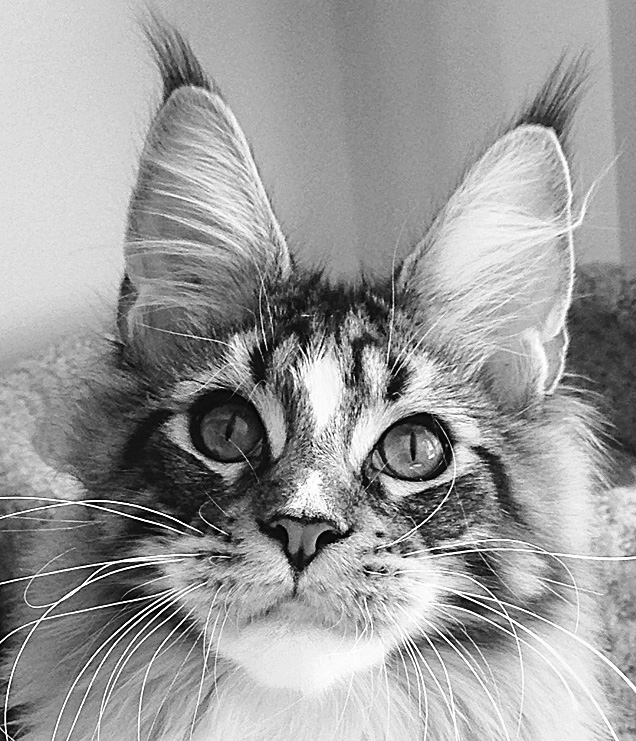
Maine Coon cats are the gentle giants of cats. They are agile, active, and very affectionate. Their long, square muzzle and large ears with lynx tips give them a distinctive and very attractive look.
David Bernbaum
Breed diversity in cats isn’t quite what it is in dogs. Dog breeds were developed for a variety of purposes (hunting, herding, protection, and so on), whereas cat breeds were developed primarily for appearance. There are currently forty-four breeds recognized by the Cat Fanciers’ Association (CFA) and seventy-one recognized by The International Cat Association (TICA)—the two largest American registries. These organizations have accumulated a fair amount of information about the temperament and characteristics of the various breeds.
Among pedigree cats, one must be mindful of breed disposition and special needs. (Again, think of Nancy and Zeus.) Before adopting a particular breed of cat, learn as much as you can about it—both good and bad—so you’ll be prepared for the lifestyle the cat may require, his grooming needs, and any medical conditions to be alert for.
For more information on cat breeds, I recommend Your Ideal Cat: Insights into Breed and Gender Differences in Cat Behavior, by Dr. Benjamin Hart, DACVB, and Dr. Lynette Hart. Another resource is Purina’s “Cat Breeds” web page (www.purina.com/cats/cat-breeds). You can also learn about cat breeds from the breed registry organizations, including CFA and TICA, online. Visiting a cat show and speaking with breeders is another option, but remember that they obviously love the breed they are raising and so will likely be biased.
When you’re adopting a kitten, his personality and behavior are far more important than his appearance. Personality and behavior traits are influenced by a complex interplay of genetics, prenatal conditions, early learning, and experience.
A kitten’s individual genetics play an essential role in how social, playful, fearful, or confident he will be. Friendliness is likely a strong genetic trait and has been shown to be inherited from the father (called the tom). Unless you’re adopting a pedigree cat, though, the father is often no longer in the picture when you meet a litter of kittens, so you usually don’t know what he is like.
The mother (called the queen) contributes her part genetically, but normal development of a kitten relies strongly on a healthy mother who had proper nutrition during pregnancy and is attentive to him. Kittens who are raised together and learn from their mother (and one another) about both the world and feline social structures, social cues, and cat language are more well-adjusted than those who lack a healthy, attentive mother. Orphaned and hand-raised kittens have a tendency to be overly cautious, fearful, or aggressive as adults. Neglected kittens, or kittens from ill or malnourished mothers, may develop medical conditions or have behavior problems as they mature.
In addition to the genetics of both parents and the health and early lessons provided by the mother, early handling, especially during the sensitive socialization period, also significantly contributes to a kitten’s adult personality. Kittens who are handled just fifteen minutes a day from birth are more social, more willing to explore, and more able to handle stress as they develop. They are also likely to be more social with people when placed in a new home after weaning.
The most sensitive socialization period is thought to be between two and seven weeks of age, so the greater exposure a kitten has to humans of all ages as well as other pets, environments, and situations during that time, the better adjusted that kitten is likely to be.
That being said, there is evidence to suggest that gentle handling and exposure to people, other pets, and environmental stimuli even up to twelve weeks of age can be highly beneficial. So if your kitty is older than seven weeks, hope is not lost for helping him come out of his shell. And even if your kitten did get the opportunity to be socialized before seven weeks of age, you will still have work to do. Those early positive associations are best maintained through repetition and practice.
There are some behavioral differences between male and female cats that can’t be attributed to breed differences. According to research by Dr. Benjamin Hart, DACVB, and Dr. Lynette Hart, males show a much higher tendency for friendliness, playfulness, activity, and affection toward their human family than females, but they also rank higher in urine marking. Neutering greatly reduces this marking behavior, but it can still be seen in approximately 10 percent of neutered male cats, whether they are neutered as kittens or as adults.
Females show more aggressiveness toward both people and cats and are typically reported to be more fearful than males. They do rate higher on good litter box use, though.
Despite these tendencies, individual variations in personality and behavior are more important when choosing a cat. Picking a cat based solely on male vs. female can be less effectual than picking one based on individual characteristics.
Do temperament tests work? Assessing very young kittens can be of limited value if they are still progressing through their sensitive socialization period. A kitten’s receptivity to socialization begins to decline at about seven weeks of age; after that age, behavioral assessments may be increasingly more reliable in predicting a kitten’s behavior as an adult. Assessing older kittens and adult cats can provide even more accurate information. Studies have shown that many aspects of cat personality remain stable over time once the animal is four to five months of age.
How old should a kitten be before you adopt him? Recent research recommends that if the kitten can stay in a stable environment with his mother and littermates, adoption is best after fourteen weeks of age. One study found that cats weaned at a later time had a lower likelihood of becoming aggressive toward strangers, as well as a lower probability of developing stereotypic behaviors (such as excessive grooming), than cats weaned earlier.
That being said, many kittens don’t have the advantage of stable maternal care. Often kittens in shelters and rescue settings are adopted at eight weeks of age. If your kitten can’t stay with his feline family until fourteen weeks of age, at least you can positively expose him to humans of all ages, other pets, and novel situations when you take him home.
Is it better to adopt a kitten or a cat? Kittens are undoubtedly cute and fun to watch and play with. However, kitten behaviors, though often YouTube-worthy, can be overwhelming. Kittens generally jump, scratch, and bite and are very active at night. If kitten antics aren’t high on your wish list, consider adopting an adult or senior cat. Older cats are less likely to be noticed among the cages of frisky, playful kittens at a shelter and are adopted at lower rates. With fully mature cats, what you see is what you get. In other words, you already know their size and personality.
Adopting an adult cat may present its own difficulties, as he may not adapt as readily to your household and any other pets you may have. Adult cats generally have a longer and more challenging integration period with other adult cats than kittens do. If you adopt an adult cat from a shelter, he may have been surrendered for behavioral reasons that were not disclosed by the previous owner. Sometimes these behaviors are not evident in the first few days or even weeks of adoption. If there are behavioral concerns, many owners think that the cat just needs some time to adjust, which in many cases is true—but in many cases is not.
Despite these warnings, be open to adopting an adult cat. Many turn out to be terrific pets and live wonderful, enriched lives in their new homes. Just be careful, and if you have other cats in your home, introduce them slowly. (See chapter 5 for more about cat-to-cat introductions.) Also understand that on occasion, you may find a cat who, albeit adorable, may not be the best fit for your household, family, or other pets and is not suitable for your home.
Should you adopt one cat or two? If you’re thinking about adopting a cat or kitten, consider taking home two. Cats need exercise, mental stimulation, and social interaction. Two cats can provide this for each other. Not all cats are going to be friendly with each other, so this works best with kittens and adult cats who came from the same home and ended up in the shelter together. Many shelters try to keep bonded cats together. Two littermates will have a closer relationship than two unrelated individuals, and a mother and kitten will generally have a close bond and do well together.
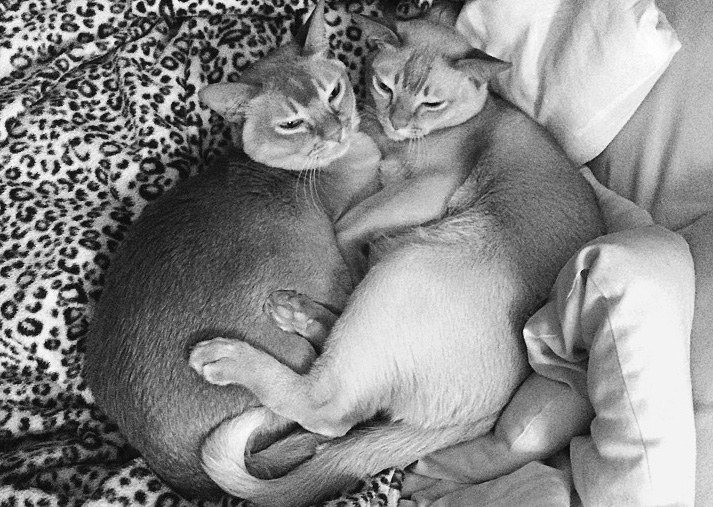
Dolce and Rudy are a pair of Burmese who were adopted together at a young age, allowing them to develop and maintain a strong bond throughout their lives.
Kathy Prinz
Getting a new adult cat as a companion for an already established adult cat in your home is not always so successful, and introducing the two cats should be done carefully (see chapter 5). Adding a second cat can result in behavior problems, such as fighting or urine spraying. And make sure you are prepared financially, as having two cats means twice the food, twice the litter, and twice the medical care.
Should a cat live indoors, outdoors, or both? I find many cat owners are now allowing their cats outside for part of the day as an enrichment activity. Often they explain that the cat was taken in as a stray and continues to “ask” for outdoor time. The cat likes to climb trees, lie in the sun, chase birds, and hunt lizards. There is, indeed, no match for the great outdoors when it comes to feline enrichment.
That being said, the outdoor life comes with risks, and many owners choose to provide enhanced indoor enrichment rather than outdoor exposure. Fenced-in cat yards, cat patios (catios), and harness walks have fewer risks, but depending on the situation, they have their own dangers. Discuss all these risks with your veterinarian before allowing your cat outside.
Undoubtedly, an indoor cat is safer than an outdoor cat. Not only are outdoor cats susceptible to infectious diseases such as FIV, but there are other viruses, parasites, toxins, predators, and injuries to worry about as well. Whereas indoor cats live, on average, from twelve to fifteen years, cats who spend some time outdoors live two to three years less.
Risks for outdoor cats include:
Infectious diseases, including FeLV, FIV, feline infectious peritonitis (FIP), feline distemper (panleukopenia), and upper respiratory infections spread by stray, feral, or un-cared-for cats
Cat fight injuries
Trauma (hit by a car or other trauma)
Toxins (antifreeze, rodenticides, herbicides, fertilizers, and others)
Predation (dogs, coyotes, cougars, large birds of prey, and others)
Trapping by neighbors (who may then relocate the cat, take him to a shelter, or even kill him)
Malicious actions by humans
There is no doubt that cats who have outdoor access have an assortment of enrichment opportunities to keep their minds and bodies active and engaged. As cat owners who want to keep our feline family member around as long as possible, and also be responsible pet owners and neighbors, we can provide similar enrichment for our cats indoors. Chapter 3 has some wonderful ideas for feline enrichment, and chapter 12 offers some suggestions for how to let your cat go outside in a safer and more controlled way.
Here are some tips for finding your perfect kitten.
Look for a kitten who had a healthy mother and who was raised by her and with his littermates—ideally, until fourteen weeks of age.
If both parents are present, look at their behavior. Friendliness toward humans is strongly influenced by the father. The mother contributes her genetics as well, and her mothering skills are important in shaping a healthy, social kitten.
Try to find a kitten who has been handled frequently, preferably for at least fifteen minutes every day, during the sensitive period of two to seven weeks.
A kitten who has been positively exposed to adults and children both inside and outside the home is more likely to develop into a socially stable cat. If your kitten is going to be around dogs, it is helpful if he was previously exposed in a positive manner to them as well.
Does the kitten approach people, or does he run away or freeze? A kitten who freezes or runs away is fearful and will likely take more time to socialize or desensitize to people. If you are looking for a social, outgoing cat, a fearful kitten may not be your best pick.
How does the kitten react to being properly picked up? To test this, gently pick him up with one hand under his chest and another cradling his back end, so he feels safe and stable. If he fights, freezes, or tries to flee, he is a timid, fearful cat and will require more of your time and effort to become more relaxed with you. He also may be unsuitable for small children, who may not be careful in handling him.
Ask if the kitten is using a litter box. Kittens develop litter and litter box preferences before five weeks of age.
Here are some tips for finding your perfect adult cat.
The sensitive socialization period is over, so what you see is what you get in an older cat. You’ll have a fairly good idea of the cat’s personality right away.
Ask yourself what kind of personality you are looking for in a cat. Shelter staff, foster caregivers, and rescue volunteers can often help steer you to the right cat.
Take into consideration where you are meeting this cat for the first time. Many environments, such as rescue organizations and shelters, can be stressful for a cat, so you may not get to see the best, most relaxed side of him. Try to meet him in a quiet area, and spend some time with him. Perhaps visit more than once.
If possible, try to find out why the cat is available for adoption. Did he have behavior issues in his previous home, or was the family simply unable to keep him?
If the cat has a medical issue, make sure you have the time and financial resources to take care of him.
When you bring your cat home, kitten or adult, a trip to the veterinarian to check out your new family member should be the first thing on your agenda. You want to make sure you are starting out with a healthy cat. And if you have other pets at home, you don’t want to spread any infectious diseases or parasites to them.
If the cat or kitten had some veterinary or medical care before you adopted him, make sure to get a written record of what was done. That record should include medication and vaccination names, doses, and dates they were administered. Bring this to your veterinarian so that she can give you the best possible medical advice and recommendations. If possible, bring a fresh stool sample for a fecal parasite exam. The sample should be less than twenty-four hours old and can be placed in a small plastic bag or container.
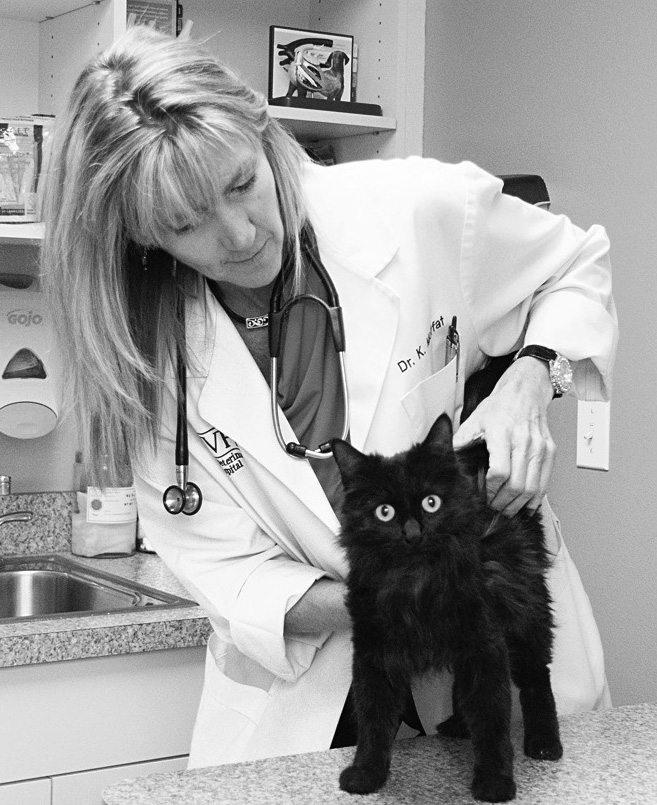
A stray adult cat found on a doorstep gets her first full exam.
Sharon Witherspoon
If you don’t have any previous medical records for your new cat or kitten, the veterinarian will run FeLV and FIV tests, perform a fecal exam, and administer vaccinations. She also will do a thorough physical exam to check for common ailments such as upper respiratory infections, ear mites, dental disease, external parasites, and other skin diseases such as ringworm. She will talk to you about internal and external parasites, and depending on findings and the cat’s circumstances, she may prescribe a deworming medication or flea and tick preventive.
If the cat is not already spayed or neutered, discuss the procedure, the cost, and the best time to schedule it.
Hopefully, your veterinarian will also ask about the cat’s environment, whether you will be traveling with him in the future, and what his exposure will be to other cats and animals. This will help her develop the best medical plan for your cat.
Ask about microchipping as a means of identification. In this procedure, a small microchip, about the size of a grain of rice, is implanted under the cat’s skin between the shoulder blades. That chip has a unique number on it that can be picked up and read by a scanner. Many indoor-cat owners do not think their cat needs one, but unfortunately many of these cats can and do escape. According to the research, the return-to-owner rate for cats is twenty times higher for microchipped pets than for all other stray cats in shelters.
There are a few items you should have ready before you bring your new cat home.
Food. Find out what your cat has been eating at his previous home and start with this. You can always transition to a different diet. If you decide you want to do that, do it gradually over about a week to avoid gastrointestinal upset or stress on the cat.
Bowls for food and water.
A cat carrier. If you are planning on airline travel, make sure the carrier is airline approved. A carrier with a removable cover works best for veterinary visits. Two kittens may fit in one carrier, but as they grow into adulthood, two separate carriers are better.
Litter box(es). Choose a box that will be one and a half times the size of your cat when he has grown to adulthood. Most cats prefer an uncovered box. A kitten may need a box with lower sides to begin with.
Litter. Most cats prefer sandy, clumping litter. You may want to ask what the cat has been using and start with that. As with food, transition slowly if you want to make a change.
Toys. Avoid toys with long strings or small parts that could be ingested.
A scratching post. It should be heavy and sturdy enough that it won’t get knocked over, and tall enough to allow the cat (as an adult) to reach up and fully stretch to use it. Many cats also like a horizontal scratching surface.
Cat trees and perches. These are excellent enrichment items. Place them in areas where your family spends time and in front of sunny windows. They might include tents, boxes, or other hiding spots for those times when your cat wants to be out of sight.
Find a cat whose personality will fit your present and future lifestyle. That may be an adult cat or a kitten, a particular breed or a mixed-breed. Don’t forget to consider the other pets in your household and how they may be affected by and respond to a new addition.
Realize that cats often live more than fifteen years. Take into account their longevity and the care your cat will need over all that time.
Do you know the history of the kitten you plan to adopt? A kitten raised by his mother, with his littermates and with human contact and a variety of environmental exposures, is likely to be friendlier and less fearful in his adult life than one who didn’t have these advantages.
Look into your options for finding a new cat or kitten. The pet overpopulation crisis may point you to the more socially conscious decision to adopt from a shelter or rescue group, or to take in a homeless stray. Several medical and financial decisions come into play here, as shelter cats have generally already been evaluated medically, vaccinated, and spayed or neutered.
If you choose a cat from a rescue group, make sure the group is reputable and you obtain the cat’s medical records.
With a stray, you are starting with little or no history and should have the cat immediately checked out by a veterinarian for infectious diseases, parasites, and any other health issues.
If you want to adopt a pedigree cat, make sure you research the breed extensively and are aware of breed behavior traits, grooming needs, and disease susceptibilities. Choose a reputable breeder.
Select a veterinarian ahead of time and schedule a visit within the first few days of getting your cat.
Purchase food, bowls, litter boxes, litter, a carrier, and toys for your new arrival before you bring him home.
Enjoy your new best friend!